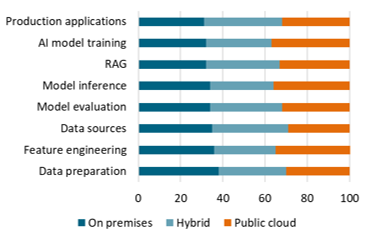
Oracle AI Data Platform and the Power of Incumbency
Oracle’s new AI Data Platform, unveiled at Oracle AI World, quickens the pace of cloud adoption and artificial intelligence (AI) innovation. Perhaps more importantly, it builds on Oracle’s heritage as an incumbent provider of on-premises systems. Cloud competitors AWS, Google, Databricks, and Snowflake lack this heritage business. Among the gorillas, only Microsoft has a similar legacy.
To be sure, Oracle has made big strides in cloud computing. CEO Clay Magouyrk described in detail the performance, cost, and security characteristics of Oracle Cloud Infrastructure (OCI) during his keynote. These characteristics contributed to 55 percent annual revenue gains for OCI and an overall 4x jump in backlog in Q3—heady growth for a company that went public before Sam Altman was born.
It’s a Hybrid World After All
But part of that growth stems from Oracle’s installed base on-premises. That base matters because enterprises still do a lot outside the cloud. In fact, a BARC survey earlier this year revealed that 1/3 of overall AI workloads reside on premises, 1/3 in hybrid environments, and 1/3 in one or more clouds.
Where does your organization host the following components of its AI projects? (%) (n=318)

Myriad tables, documents, and other AI inputs sit in companies’ data centers—and often in Oracle databases—thanks to data gravity and sovereignty concerns that keep it off the cloud. The Oracle AI Data Platform integrates with these systems to provide a governed hybrid environment for data and feature engineering; model training and development; and production inference. Organizations can access advanced AI tools, apply them to data on-premises, and migrate to OCI without changing vendors. They can also get cloud-like Oracle capabilities on premises.
An integrated stack
Oracle offers a full AI stack to simplify AI innovation across these diverse locations, as well as diverse models, tools, and applications. This integration extends in two directions: on-prem to the cloud, and bare metal infrastructure to applications and agents. Such integration helps enterprises consolidate elements, automate processes, and foster team collaboration as they put AI to work. Oracle still integrates with a broad commercial and open-source ecosystem, with support for popular projects such as Apache Spark, Delta Lake, Hudi, and Iceberg.
To understand what all this means to the professionals who make AI work, let’s consider three critical lifecycles.
Data operations
Data teams use the lifecycle of DataOps to optimize data management for agentic AI. They apply DevOps practices such as testing and continuous integration (CI) and continuous delivery (CD) to the creation, deployment, and iteration of data pipelines. This lifecycle helps data engineers build effective pipelines for structured or unstructured data. They can make frequent changes as they label images, convert text to vector embeddings, and so on.
Oracle supports much of the DataOps lifecycle, although CI/CD and version-control processes require integration with outside platforms such as GitHub. Data engineers can author, schedule, and monitor workflows for data ingestion and transformation within the Oracle AI Data Platform. And they can work with data scientists and machine learning (ML) engineers to centralize metadata for AI inputs.
Model operations
AI teams adopt the ModelOps lifecycle to optimize the models that contribute to agentic AI. For example, they make frequent adjustments to the creation, deployment, and iteration of machine learning models. Data scientists train and tune effective ML models, and ML engineers deploy and iterate them in response to changing business conditions. These stakeholders can also use ModelOps to implement and refine ML models that evaluate the accuracy, toxicity, and relevance of GenAI outputs.
Oracle supports critical aspects of the ModelOps lifecycle on its AI Data Platform. Data scientists can access models from public libraries such as PyTorch and TensorFlow, then customize, train, and test them on the Oracle AI Platform. Oracle users can also access major pre-trained GenAI models from OpenAI, Cohere, Google, and other vendors, using prepared enterprise data and configuring retrieval-augmented generation to reduce hallucinations.
Agent operations
Data scientists, ML engineers, and developers adopt agent operations (AgentOps) to build, deploy, and iterate agents. They test, monitor, and tune complex agentic workflows, especially their interactions with GenAI and ML models. They inspect agent outputs and actions with a focus on safety. Oracle AI Platform assists these processes, for example, by enabling agent creation and orchestration, and integrating with the popular MCP and A2A protocols.
Conclusion
While innovative technologies disrupt many incumbent vendors, they also help the incumbents that move fast to capitalize on their home-court advantage. This is the story of Oracle in 2025, and it explains why the AI Data Platform will pose a competitive threat to other AI development platforms.

 - by
- by




